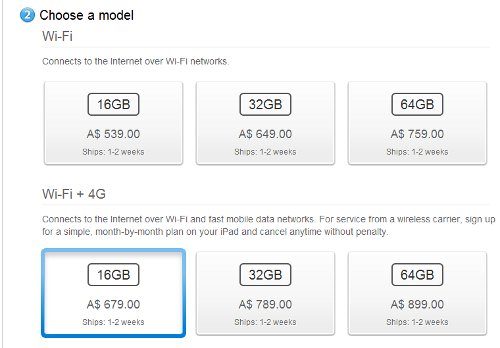Apple has reportedly agreed to refund buyers of the new iPad in Australia who are disappointed to find it does not offer 4G speeds. The company may face similar problems in Sweden and the United Kingdom.
The 4G feature on the new model only works on specific wireless frequencies, namely 700MHz and 2100MHz. Those aren’t used for 4G (LTE) services in all countries, such as Australia which uses 1800MHz. Buyers there have found the 4G version of the iPad automatically switches to a 3G connection — faster than the cheaper version of the new iPad, but considerably slower than 4G.
What makes things more confusing is that in all countries the more expensive model is dubbed the “WiFi + 4G.” However, at launch time it appears Apple didn’t make the compatibility issue entirely clear on its website for Australian visitors, instead simply including a note inside the packaging itself.
That’s prompted a threat of a lawsuit from the Australian Competition and Consumer Commission. It now says Apple has agreed to include the statement ” This product supports very fast cellular networks. It is not compatible with current Australian 4G LTE networks and WiMAX Networks” on all marketing materials in the country and ask resellers to display a notice to that effect.
It doesn’t yet appear Apple is willing to agree to initial demands that it should change the name of the device when selling it in other countries. That could involve some major administrative headaches.
There are similar problems in Europe, where the 4G feature is also of limited use. Swedish consumer officials have questioned whether the marketing is legal, while theUK’s advertising regulator is investigating complaints.
Meanwhile Apple has tried to clear up confusion over battery life in the new iPad. There’s been some concern that two identical devices starting from a “100 percent” charge and carrying out the same activities don’t have the same battery life.
Apple has now explained that the new device, as with all previous iOS gadgets, goes through a charge and discharge cycle when it is plugged in and almost full. Once the battery is genuinely full, it discharges a little then recharges again, continuing this process until it is unplugged, a measure designed to keep an “optimum charge.”
The confusion comes about because the battery display reads 100 percent at all stages of this top-end cycle. Apple insists that no matter what stage is reached at the point the device is unplugged, users will still get the full 10 hours’ life (for average use) mentioned in marketing materials.
Part of the confusions may also lie in the fact that a thicker battery in the new iPad, designed to support the extra screen and graphics demands, takes a little longer to fully charge than in previous iPads.

